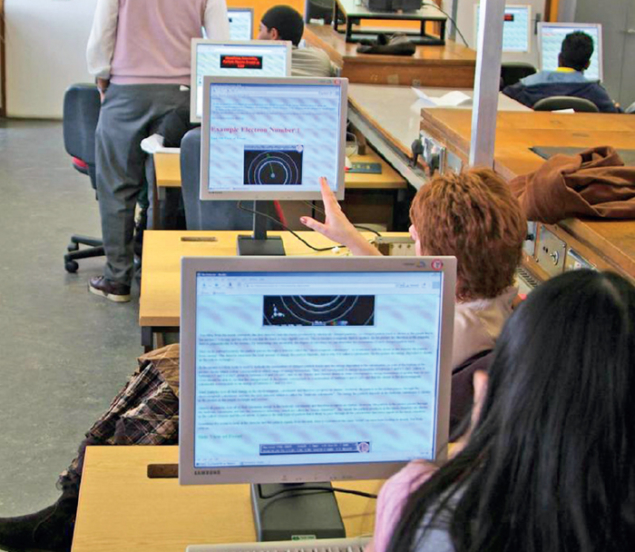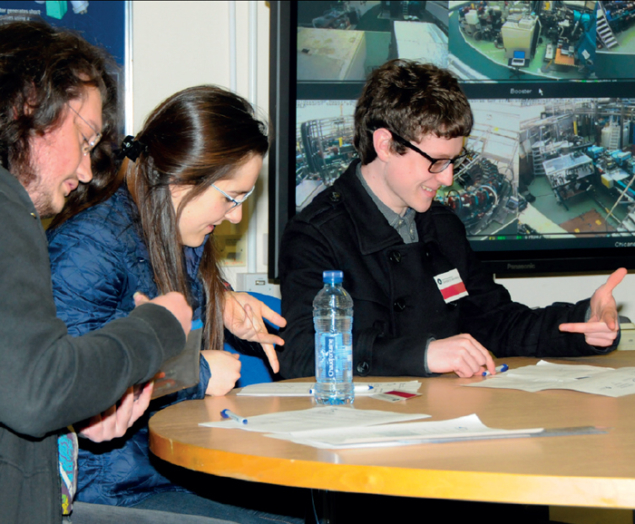A look back to the origins of the masterclasses in 1996.

Image credit: CNRS/LAL.
Today, the Particle Physics Masterclasses are so well established that they seem always to have been there. As many as 10,000 school students in 37 countries participate each year at an international level. Perhaps those who are involved in these events that enthuse and inform the younger generation never wonder about how they started. But there was a time when there were no such things as masterclasses in particle physics and they had to be invented.
The start can be dated precisely: it was in a discussion between Ken Long and myself that took place during a coffee break at the committee meeting of the UK Institute of Physics (IOP) High-Energy Particle Physics (HEPP) group on 17 October 1996. We were frustrated at difficulties with outreach – or the public understanding of science, as it was then called – to schools. Particle physics had a great story to tell, with fine pictures and enthusiastic speakers, but schools were slow to respond to our offers to visit and give talks. Our words and pictures could not compete with the colour and noise of chemists and the experiments they included in their lectures. Surely it was impossible to show real particle physics in the classroom? As Ken and I talked, bits of the answer came together and more followed over e-mail discussions in the succeeding weeks:
• Rather than go to schools and talk to a dozen pupils, we would invite them to come to us, in university lecture theatres that could accommodate hundreds of people.
• A full-day event would make the trip worth their while and allow time for a range of topics and activities.
• We would run the event from local universities but consider it a national event and organize publicity centrally using the IOP.
• Most important, we would use the new computer clusters that were being installed for undergraduates but not used much outside of university term time.
The computer clusters could run serious software experiments directly related to real particle physics – participants could learn through doing. The World Wide Web, which was new at that time, could be used for distributing the programs and data. Today, we just point and click, but in the early days we had to be concerned with network speed, so the programs were painstakingly pre-loaded to each PC before the sessions.

Image credit: QMUL.
I suggested the name “Masterclasses” with some hesitation because it seemed pretentious: we were not offering one-to-one violin tuition with Yehudi Menuhin. However, it did capture something of what we were trying to do and the name has stuck. At the meeting of the IOP HEPP group committee in January 1997, Ken and I presented our plans for Imperial College and Manchester University (where I worked then), and people liked them. Christine Sutton at Oxford, Mike Pennington at Durham and Tim Greenshaw at Liverpool decided to take part. These were the individual enthusiasts but we also received tremendous support from many colleagues, both in the particle-physics groups and from the computing staff.
We decided that although we could not provide a big-name speaker for every session, we could distribute a video of a public session arranged as part of the IOP HEPP group conference, which in 1997 was to be held in Cambridge to celebrate the centenary of J J Thomson’s discovery of the electron at the Cavendish Laboratory. Ken arranged for video recording (with all of the legal and copyright details) of the talks given by Stephen Hawking and Frank Close. The videos were shown at the masterclasses just a few days later and each participating school was given a copy to take home.
While Ken was arranging the video, I was organizing the universities. On 13 February we had a planning meeting in Manchester, with Swansea and Lancaster joining as well. We also discussed publicity, arrangements and the provision of “goody bags” for pupils and teachers. We tried out the software, which included the Lancaster relativistic-kinematics package and Terry Wyatt’s web-based “Identifying Interesting Events at LEP”.
The real thing
Terry’s package was revolutionary in that it gave school students real particle-physics data and real tools, and asked them to make decisions. Presented with simple Z decays from the OPAL experiment at CERN’s Large Electron–Positron (LEP) collider, the students had to classify them as electron, muon, tau or quark decays, according to the patterns in the detector. The only difference from actual analysis was that such a classification would not be done by a physicist, but by a program using criteria devised by a physicist. Terry and I had spent a lot of time puzzling over the OPAL event display to understand the detector for the first muon-pair results, so I can certify that this exercise was close to real research.

Image credit: STFC.
After the annual IOP conference in Cambridge I came back to Manchester, and the next day – 11 April – we ran our first Particle Physics Masterclass. In my journal I wrote “nice talks, kids co-operate and teachers are enthusiastic and appreciative”. The only glitch was that we under-estimated appetites and lunch ran out. We learnt our lesson and the following year we provided smaller plates. The other pilot sites were similarly positive. There was high demand from the schools – some places ran a second day – and both pupils and teachers who attended were enthusiastic afterwards.
The basis for the masterclasses was “Think globally, act locally”. It was a national campaign – we always specifically referred to it as the National Particle Physics Masterclass – with central publicity and preparation of materials. However, the shows were run by local groups, in their own way and with local variations. They could plug their own institution as much as they pleased – the Oxford website managed to include the word “Oxford” six times on one small page – and adapt the material freely, using events from the DELPHI experiment, rather than OPAL, for example.
The scheme was written up in the HEPP group newsletter (January 1998), stressing what we saw as the key parts of the scheme:
• It is not just talks. Using PC clusters can get the participants involved in an activity that is not far from real research.
• A central organization spreads the administrative load.
• A national scheme spreads the publicity.
• It runs every year at the same time, linked to the annual IOP HEPP group conference in the spring vacation, so there is no problem in deciding when to do it.
The idea snowballed, so that in 1998 nearly every university particle-physics group in the UK ran a masterclass – and have done ever since. The national Rutherford and Daresbury labs joined a year or so later.
There was continued strong support from the IOP HEPP group
The Particle Physics Masterclasses have flourished. There was continued strong support from the IOP HEPP group – Val Gibson took over the co-ordination when I came off the committee – and from the Particle Physics and Astronomy Research Council, where Andrew Morrison did a splendid job of liaison. They provided co-ordination and literature, respectively, but not money. We received repeated offers of financial assistance but turned them down as the scheme basically cost nothing. It was run by enthusiast particle physicists who did not need extra support.
Onwards and upwards
The masterclasses have adapted with time. The LEP events were replaced by ones from the Tevatron and from the LHC. The number of pupils who have attended the classes must be into the tens of thousands. A prime minister has been photographed with participants, and the masterclasses idea has spread to continental Europe and across the Atlantic.
I think this success comes from a combination of many factors. Particle physics has, of course, a great story to tell. Masterclasses are run by enthusiasts who do it purely for fun and because they want to, and they treat the material with familiarity rather than respectful awe. We grasped the technical development of the university PC clusters for analysis and the power of the web for distribution at the right moment.
This success has brought benefits: applications to study physics in UK universities are rising, and the public and the media are interested and excited about the LHC and the Higgs boson. Agreed, the masterclasses cannot claim all of the credit for this, but they can certainly claim some of it.
Now, the Particle Physics Masterclasses face the challenge of evolving as technology moves on and people – especially young people – change with it. I hope they see continued success by building on the basic ideas that they started with, and that they will continue to provide fun for students and organizers for many years to come.







